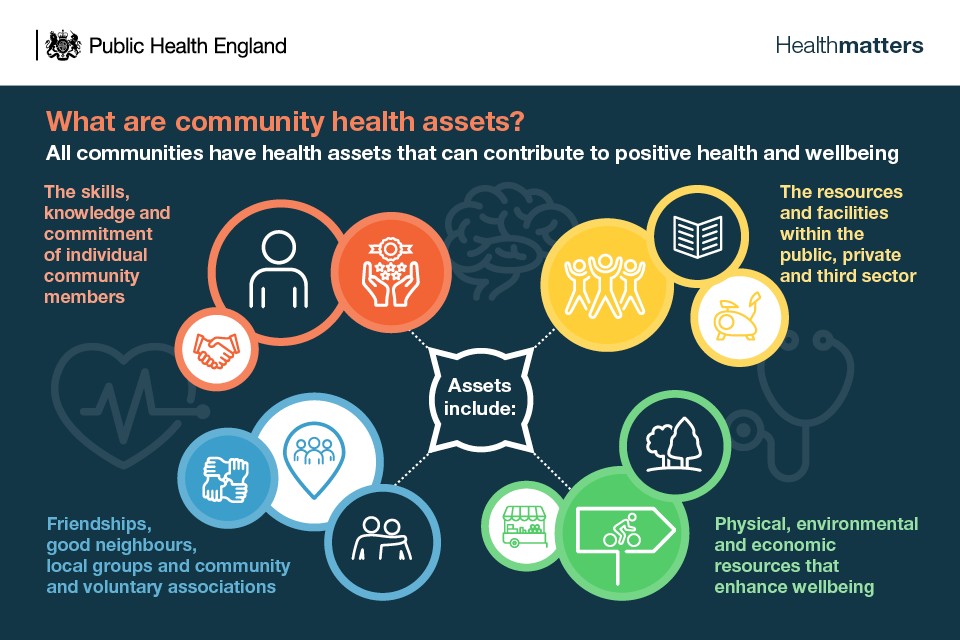This guide explores the concept and practical application of community-centred approaches for health and wellbeing, outlining how to cultivate environments where community assets can thrive.
Why Focus on Community?
Defining ‘Community’
The term ‘community’ represents the network of relationships, bonds, identities, and shared interests that connect individuals. These connections can be based on location, shared services, cultural heritage, or common activities.
It’s helpful to distinguish between communities of place (geographic) and communities of interest (identity or affinity), as engagement strategies may need to be tailored accordingly. Keep in mind that communities are fluid, and people’s affiliations can evolve over time and in varying social contexts.
Community Determinants and Their Impact on Health and Wellbeing
Achieving positive health outcomes requires addressing the factors that protect and promote health and wellbeing, many of which exist at the community level.
Community life, social connections, and a sense of agency in local decision-making are crucial contributors to overall health and wellbeing. These community determinants build resilience and control, acting as a buffer against disease and influencing health-related behaviors.
Empowering local communities, particularly disadvantaged groups, is key to promoting health and wellbeing and reducing health inequities. Participatory approaches can directly tackle marginalization and powerlessness, often proving more effective than professionally-led services in mitigating inequalities.
Communities possess a range of assets that contribute to the positive health and wellbeing of their members:
- Skills, knowledge, social competence, and commitment of individuals
- Friendships, intergenerational solidarity, community cohesion, and neighborliness
- Local groups, community and voluntary associations (formal and informal)
- Physical, environmental, and economic resources
- Assets contributed by external agencies
Recognizing these assets helps value community strengths and ensures equitable access. It builds on positive attributes and fosters a collaborative approach to health action between communities and services.
Community-centred approaches are vital across all facets of public health, including health improvement, health protection, and healthcare public health. The goal isn’t to overburden communities or cut public spending, but to invest in more effective and sustainable approaches that reduce health disparities.
Understanding the Current Landscape
Surveys like the Community Life Survey provide valuable data on community attitudes and behaviors. They track trends related to social action, community empowerment, volunteering, neighborhood perceptions, civic engagement, and overall wellbeing.
For example, the Community Life Survey findings showed that a significant proportion of people felt a sense of belonging to their neighborhood. Volunteering rates were also tracked, providing insights into community engagement levels.
Community involvement in local decisions is another key area assessed. The survey reveals the percentage of people who feel they can influence decisions affecting their local area and the proportion who would like to be more involved.
Furthermore, the survey monitors feelings of loneliness, offering insights into social isolation within communities.
Evidence Supporting Community-Centred Approaches
Research consistently demonstrates that health inequalities persist, and many individuals experience social exclusion or a lack of social support. The Marmot Review highlights the need to improve community capital and reduce social isolation to effectively reduce health inequalities.
Social relationships significantly influence health inequities. Critical factors include control over resources and decision-making, access to social networks, and communal capabilities.
(UCL Institute of Equity, 2013)
Guidance from organizations like the National Institute for Health and Care Excellence (NICE) emphasizes community engagement as a key strategy for health improvement, leading to services that are better aligned with community needs.
Community-centred approaches are also essential for health and social care services. Strategic visions emphasize the need for a new relationship with patients and communities. There’s a shared commitment across national agencies to work collaboratively towards this goal.
This aligns with strategic objectives to improve health and wellbeing and reduce health inequalities through place-based approaches that:
- Develop local solutions leveraging community assets and resources.
- Integrate public services.
- Build community resilience.
Building Social Capital Through Community-Centred Initiatives
There’s growing interest in community-centred approaches to enhance individual and community capabilities, create healthier environments, and address health disparities.
These approaches go beyond simply being community-based; they focus on mobilizing community assets, promoting equity, and empowering individuals to take control of their health and lives.
Key elements include:
- Utilizing non-clinical methods.
- Employing participatory approaches (active community involvement in design, delivery, and evaluation).
- Reducing barriers to engagement.
- Leveraging and building on local community assets.
- Collaborating with those most vulnerable to poor health.
- Addressing the root causes of poor health.
- Focusing on community-level factors like social networks, social capital, and empowerment.
- Increasing individual control over health.
The Value Proposition: Why Invest in Community-Centred Approaches?
While many local authorities are embracing community-centred approaches, the challenge lies in scaling up these initiatives to create a whole-system, asset-based approach.
Although robust evidence on the costs and economic benefits of community-centred approaches is still developing, they offer a unique way to utilize local resources, and emerging studies demonstrate a strong social return on investment.
Examples of positive returns on investment:
- Timebanking
- Befriending programs for older adults
- Community navigator programs
Research highlights the significant value individuals place on factors such as volunteering, social connection, and trust within their communities.
Exploring the Family of Community-Centred Approaches
The ‘family of community-centred approaches’ framework offers practical, evidence-based options for improving community health and wellbeing and reducing health inequalities.
Many localities have successful community-centred practices. The goal is to scale up these approaches to create a comprehensive, community-led system that leverages the diversity of grassroots organizations and members.
This guide highlights successful interventions within the family model implemented across various communities.
Strengthening Communities
These approaches focus on building community capabilities to address health and its social determinants. This includes community development, asset-based approaches, social action, and social network initiatives like time-banking and Men’s Sheds.
Programs like the Big Local program empower residents to improve their neighborhoods. Findings indicate that empowering communities can positively impact wellbeing through increased control, satisfaction, and belonging.
Volunteer and Peer Roles
These approaches enhance individual capabilities to provide advice, information, and support related to health and wellbeing. Individuals use their life experiences, cultural awareness, and social connections to connect with community members, communicate effectively, and reach those who may not be accessing services.
This includes roles such as:
- Health trainers
- Peer support
- Volunteer health roles
Support for mutual aid in drug and alcohol recovery demonstrates the significant contribution peer support can make to treatment effectiveness. Evidence shows that involvement in mutual aid can improve recovery outcomes.
Collaborations and Partnerships
These approaches involve collaboration between communities and local services throughout the planning cycle, from identifying needs to implementation and evaluation.
This includes community-based participatory research, area-based initiatives like healthy cities, community engagement in planning, and co-production (engaging community members as equal partners in service design and delivery).
Organizations support collaboration and co-production through alliances that amplify the voice and expertise of voluntary and community sector organizations in national policy making.
Access to Community Resources
These approaches connect people with community resources, practical help, group activities, and volunteering opportunities to meet health needs and increase social participation.
This includes approaches that improve pathways to participation such as:
- Social prescribing
- Community hubs
- Community-based commissioning
Social prescribing enables healthcare professionals to refer individuals to a range of local, non-clinical services.
Healthcare systems are working to integrate social prescribing into practice, supported by implementation tools, guidance, regional networks, and funding for local projects.
Many local plans now include social prescribing schemes.
Taking Action: Steps to Implement Community-Centred Approaches
Develop a Whole-System Approach
Empower communities by working across partnerships and sectors to maximize impact and remove systemic barriers.
Prioritize Genuine Co-design and Co-delivery
Involve community members in setting priorities, monitoring services, and evaluating initiatives. Collaborative working leads to improved outcomes and positively impacts the workforce.
Map and Mobilize Local Assets
Work with community members to identify and develop the skills, knowledge, networks, relationships, and facilities that contribute to health and wellbeing.
Commission Across the 4 Strands
Integrate community-centred approaches across public health programs.
Measure Outcomes That Matter to People
Focus on outcomes such as:
- Wellness
- Social connections
- Improved neighborhood environment
These factors can buffer against risk factors like smoking, obesity, and substance abuse. Measurement is best done at a local level, using resources that support localities.
Integrate Community-Centred, Asset-Based Approaches
Make them a part of place-based commissioning and strategic planning. Community action is a necessary component of place-based approaches to reduce health inequalities, alongside healthy public policy and prevention services.
Devolution plans can increase community power and control. Initiatives such as supporting community businesses support local economic growth and community wellbeing.

